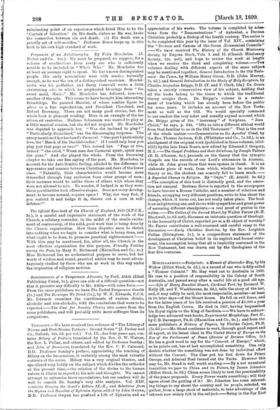THEOLOGY. — We have received two volumes of "The Library of Nicene
and Post-Nicene Fathers : Second Series" (J. Parker and Co.. Oxford ; 10s. 6d. per vol.) Vol. IX., due four years ago, con- tains Hilary of Poitiers, translated by the Rev. G. W. Watson, the Rev. L. Pullen, and others, and edited by Professor Sanday ; and John of Damascus, translated by the Rev. C. F. Calmond, D.D. Professor Sanday's preface, appreciating the teaching of Hilary on the Incarnation, is certainly among the most valuable contents of the series. Hilary was a very original thinker, and speculated very boldly on the subject which divides the orthodox at the present time,—tho relation of the divine to the human nature in Christ in regard to his acts and thoughts. We cannot attempt to epitomise these speculations, but our readers will do well to consult Dr. Sanday's very able analysis. Vol. XIII.
contains Gregory the Great's Letters and Selections from the Hymns and Homilies of Ephraim Syrus, edited by John Gwynn, D.D. Professor Gwynn has prefixed a Life of Ephraim and an
appreciation of his works. The volume is completed by Bele°. tions from the " Demonstrations " of Aphrabat, a Persian Christian, probably a Bishop of the fourth century. The series is to be completed this year by the issue of Vol. XIV., containing the "Decrees and Canons of the Seven Ecumenical Councils."
We have received The History of the Church Missionary Society, by Eugene Stock, Vols. I. and IL (Church Missionary Society, 12s. net), and hope to review the work at length when we receive the third and completing volume.—Tw1 volumes dealing with different aspects of the same subject may be mentioned together, General Introduction to the Old Testa- ment: the Canon, by William Henry Green, D.D. (John Murray, 7s. 6d.), and General Introduction to the Study of Holy Scripture, by Charles Augustus Briggs, D.D. (T. and T. Clark, 12s.) Dr. Green takes a strictly conservative view of his subject, holding that all the books belong to the times to which the traditional theory assigns them. Dr. Briggs's volume is a restate- ment of teaching which has already been before the public for some years. It includes an account of the New Testa- ment as well as the Old. We would specially commend to our readers the very sober and soundly argued account which Dr. Briggs gives of the " inerrancy " of Scripture. " Jesu Christ," he says, p. 64,4, "lifts us into a different ethical world from that familiar to us in the Old Testament." That is the root of the whole matter.—Cononentaries on the Apostles' Creed, by the Rev. Thomas Jackson, D.D. (Whittaker and Co., 7s. 6d.), is an abridgment of the original work (published in three volumes, 1613- 1657) by the late Dean Norris, now edited by Edmund J. Gregory, M.A.—The Gospel Problems and their Solutions, by Joseph Palmer (R. H. Allenson, 6s.), proceeds on the theory that the synoptic Gospels are the records of our Lord's utterances in Aramaic, while St. John gives those that were spoken in Greek. It is an elaborate piece of work, from which, whether he accepts its theory or no, the student can scarcely fail to learn much.— A Reported Change in Religion. By "Onyx." (E. Arnold. 3s. 6d.) —The conception of this book is distinctly good, and the execu- tion not unequal. Bertram Bever is reported in the newspapers to have become a Roman Catholic, and a number of relatives and friends, occupying very different positions, write to him about the change, which, it turns out, has not really taken place. The book is an enlightening one, and shows wide sympathies and great power of assuming different standpoints,—a real proof of genius in the writer.—The Cullus of the Sacred Heart, by Walter Farrar (B. H. Blackwell, is. 6d. net), discusses an intricate question of theology. Is the humanity of Christ, regarded per se, a fit object of worship ? Mr. Farrar contributes a well-reasoned and careful essay to the discussion.—Early Christian Doctrine, by the Rev. Leighton Pallan (Rivingtons, is.), is a compendious statement of the development of Christian belief in its explicit and formal state- ment, the assumption being that all is implicitly contained in the New Testament, but was drawn out by the theologians of the first five centuries.






































 Previous page
Previous page